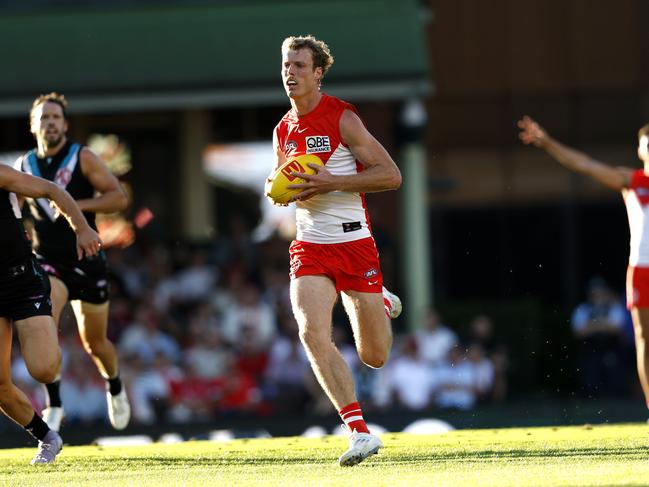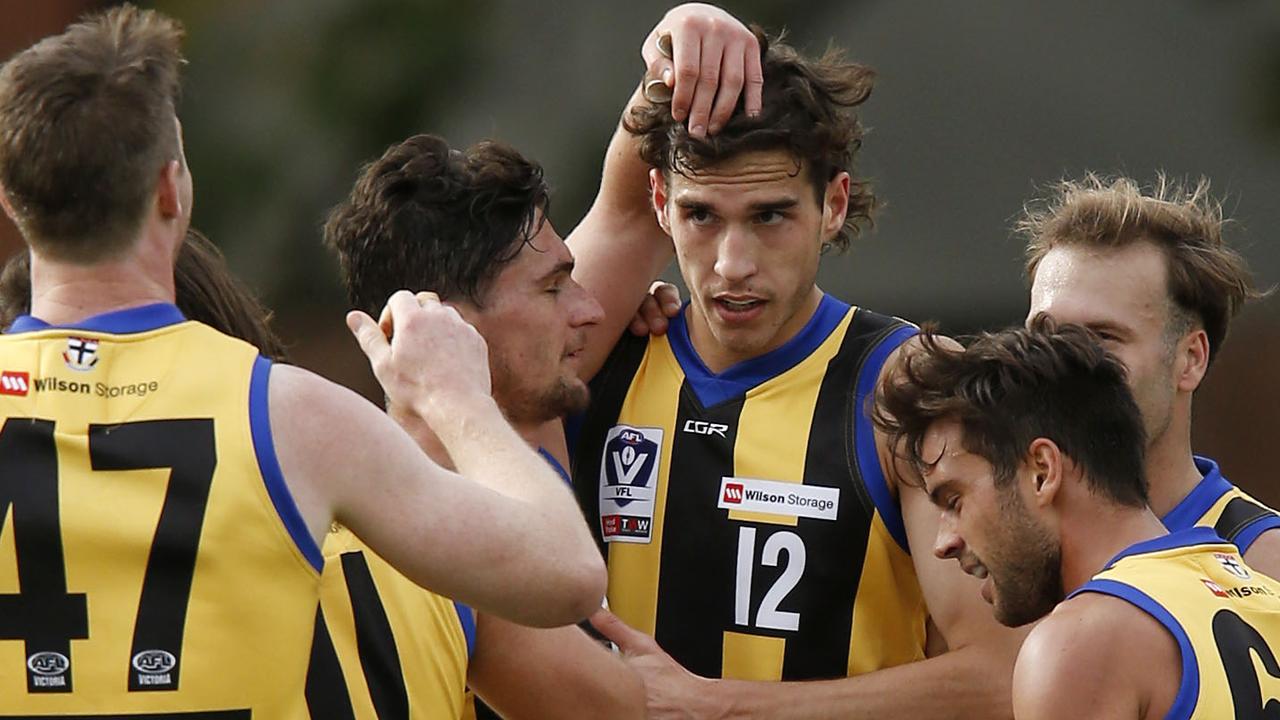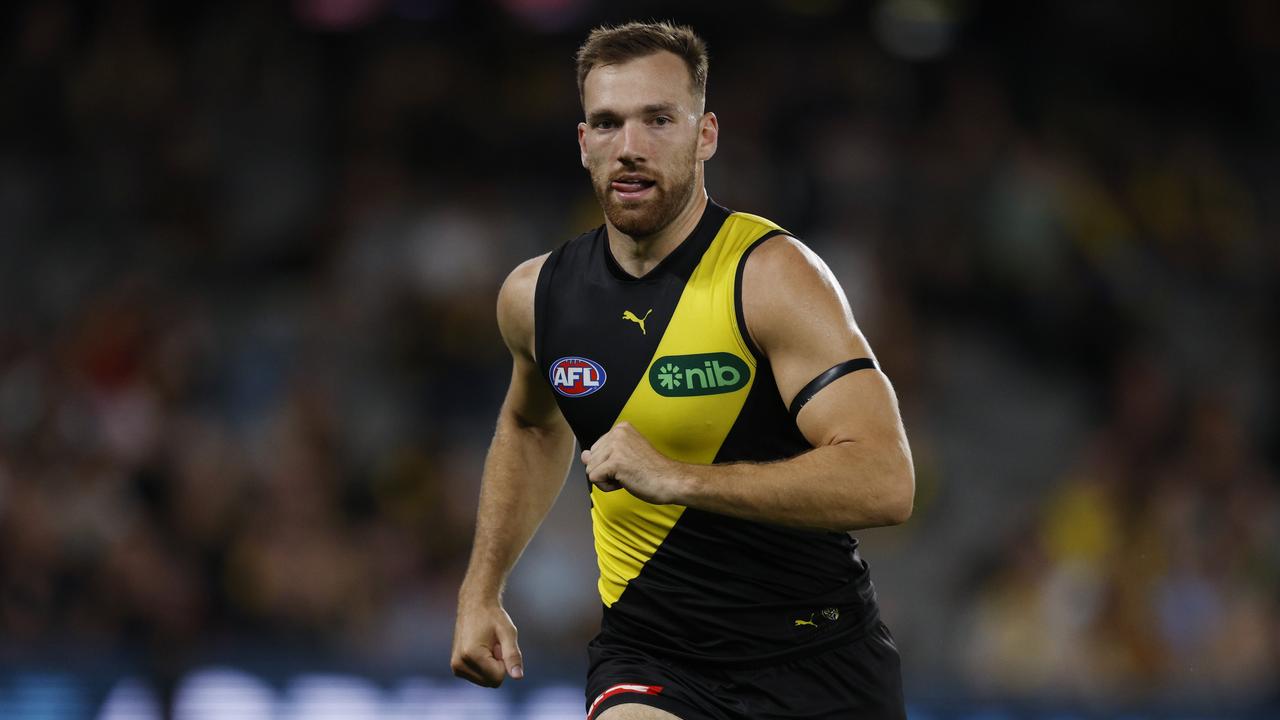Swans’ slow start examined: What’s gone wrong and why they should still be feared
The Swans’ disappointing start to 2025 has been a long way from the game style which locked them into last year’s grand final – but Lachlan McKirdy writes they’re not as far off as they might seem.

If Dean Cox had mapped out his perfect start to life as Sydney Swans head coach, it’s fair to say the first five months have deviated from the path.
Seven weeks into his first season in charge, the Swans sit 2-4, are outside of the bottom four on percentage only, have a growing injury list and look a long way from the side that claimed last year’s minor premiership and made a grand final charge.
The Swans have also drawn the criticism of former premiership coach Paul Roos, who accused them being “un-Sydney-like” and playing “Globetrotter football”
“Nineteen tackles at half time is un-Sydney-like and I got a couple of text messages from former Sydney players … (it) was un-Sydney-like,” Roos said.

Cox made no secret of the fact that he wanted to make subtle changes from John Longmire to make this team his own. But their disappointing start to 2025 will certainly force him to adapt on the fly.
Some of the changes he’s made have certainly had a positive impact. However, as the Swans look to right the ship, how much of their early-season form is down to those tweaks, bad luck or a combination of all of the above?
RUN, SWANNIES, RUN
The Cox regime began with an immediate emphasis on building fitness and running workloads. One of the first external glimpses the public received of what the new-look Swans would be was their back-to-back 2km time trials at the start of the year.
That wasn’t all the players faced, turning up to some training sessions in the Sydney summer heat that they thought would be skills-focused, only to be surprised with a session that would be entirely running.
“It’s been quite different, it’s been challenging, but not too dissimilar,” Errol Gulden said in January. “We know that it’s going to make us better in the long run.”
Unfortunately for the Swans, the early part of their season has been defined by a number of soft-tissue injuries to some of their best players.
Fourteen players were unavailable for their round one clash against Brisbane, while this weekend against Gold Coast they will still be without eight of their best 23. It remains unclear if there is a correlation between the higher loads, but Cox admitted in early March that it was a risk.
“If you want to push the boundaries as much as you possibly can and get them in the shape they need to be, you’re unfortunately going to lose one or two along the way,” he said.
“The game demands are so high now that if you don’t do that, then you’ll get caught short.”
However, even in the disappointing loss to Port Adelaide last weekend, it’s easy to see parts of Cox’s plan are working.
They ran over the Power late and clearly had all the legs in the final term. Their 15 shots at goal in the final quarter was their most in a game since 2016, and their expected score of 48 points in that quarter was their ninth-most on record.

If it wasn’t for their inaccuracy, where they kicked 5.8, they would be 3-3 and have a bit of a different outlook on the year after a victory against a top-four side from last season.
“It’s one of those ones where sometimes you’d almost rather lose by 10 goals when you come that close and have so many opportunities,” Will Hayward said.
“But in saying that, we showed a lot of fight and a lot of heart in that last quarter to give ourselves a chance.”
“We want to be a really strong, four-quarter team,” Cox added on Wednesday. “Are our metrics a lot more than what they were previously? No.
“The pleasing thing is we had some players come back … a bit slower than what we would have liked. We built them through, and they’re still building now. But it is important no matter what stage of the game we can actually fight.”
DEFENSIVE WORKLOAD AND THE CONTEST
One of the first changes Cox signalled when he took over from Longmire was a defensive reset. Motivated particularly by the way Brisbane were able to pick up uncontested marks for fun in last year’s grand final, the new coach made it clear that a new system would be implemented.
It looked particularly clunky in their first match against the Hawks with players regularly out of position and caught in transition, but in some key metrics, Cox’s adjustments have worked.
Their uncontested marks against have dropped by nearly 10 per cent, while they’re also the fourth-best team in the AFL when it comes to limiting scores per inside 50 conceded.
“There are some numbers that are pleasing for the playing group for the effort they are putting in,” Cox said. “The ability and other areas we need to work on are that intensity around the ball.
“The ability to put enormous pressure on the opposition is where we created our most scoring opportunities from previously.”
Their loss to the Power presented an unusual stat line. They won the contested possessions by 46, their best measure in two years and their fourth-best since 1999. It’s something that Cox has been calling for and believes their new defensive system will only work if they match that intensity at the contest.
And although they won plenty of ball, it was their lack of pressure without it that proved telling. They only laid 19 tackles to half time against Port Adelaide, leading former Swans coach to label them as “un-Sydneylike” on the ABC AFL Daily podcast.
Cox concedes that getting back to the ‘Bloods’ game style has to be a priority.
“That’s something we’ve got to look at,” he said. “We didn’t tackle, we were at 50 per cent efficiency. Collectively, we need to put more pressure on the opposition.
“One thing we’ve always been is a really high-pressure team. This year, we’re 13th in that area. It’s an area we need to improve at.”
BASIC ERRORS PROVING COSTLY
One of the particular areas of concern is their efficiency. Four of their most important distributors – Chad Warner, Isaac Heeney, Nick Blakey and Riley Bice – all went at less than 65 per cent disposal efficiency against Port Adelaide.
When it comes to kicking efficiency especially, several key players have fallen off a cliff in 2025. And while it’s clear they’re missing the accuracy of All-Australian Errol Gulden, it’s time for his teammates to step up.
“We’ve just got to train it,” Cox said. “Obviously for the game it wasn’t ideal, but for most part of the year our efficiency has been okay.
“Ahead of the ball we were 44 per cent inside 50 compared to (Port Adelaide’s) 38. So we had opportunities, we just didn’t take them.”
But the Swans know they need to demand more from all 23 players on the ground. Another part of Roos’ criticism this week was comparing them to the Harlem Globetrotters and suggesting that they were waiting for Isaac Heeney to bail them out.
A major focus this pre-season was bringing the entire squad closer to the level of players like Heeney and Gulden, and making sure their premiership hopes aren’t on the shoulders of their superstars. Cox admits that has been the case in recent weeks.

“We want our best players to play well, we don’t shy away from that,” Cox said. “But we want to not only rely on those single players.
“People are warranted their opinion. It’s an area we know internally we need to work on and we’ll get to work on that.
“I think that’s why we’ve lost both of those games (against Port Adelaide and Collingwood). So, we need to make sure that it’s not only our best players playing well, but the mid-tier. We need to collectively improve everyone on our list. That’s our role as coaches.”
PATIENCE IS KEY
The scrutiny on the Swans is probably a by-product of their own success. The manner of their grand final defeat last season meant all eyes would be on them, and unfortunately, they haven’t yet found their stride.
However, there’s no doubt that injuries have played a big part. Their forward line is depleted; they’re missing three All-Australian stars and could have easily beaten both Brisbane and Port Adelaide.
But importantly, we’re seeing a lot of individual development from Cox. Only six games into his head coaching career, he has admitted the decision to move Tom McCartin into attack, while out of necessity, hasn’t worked.
“This week, he’ll play back,” Cox said. “That’s one thing I put my hand up, we probably need to settle Tom.
“We have had an inexperienced forward line group. For him to do a whole pre-season, there is an option we decided to take last week. Did it work? Probably not, so we put our hands up to that.”

While that lever didn’t work, the same attention hasn’t been applied to Sam Wicks’ successful transition into a small defender. His form across the opening two months has been as good as any other small defender in the AFL.
The cavalry is also on the verge of returning. Callum Mills trained strongly on Wednesday and could return as soon as next week’s crucial Sydney Derby.
Regardless, the next month will be crucial for the Swans. The Suns and Giants pose two massive tests, before a trio of matches against Victorian clubs – Essendon, Carlton and Melbourne – could decide the fate of their season.
If the Swans can find at least two wins in that period, they’ll be within touching distance. And as they proved in 2023 with a similarly injury-disrupted year, that’s all they need with some big stars to return to still make a dent in 2025.
“Our energy needs to stay high regardless of what happens,” Hayward said. “We’ve got some young, exciting players that really thrive on that, and we try to enforce that.
“We’ve been in tough spots, but we come back to being present. It’s important when we’ve got key personnel out to keep everyone engaged, whether they’ve played five games or 150.”





To join the conversation, please log in. Don't have an account? Register
Join the conversation, you are commenting as Logout